In the vast tapestry of Greek mythology, Scamander stands out as a unique figure. Often overshadowed by the more prominent Olympian gods, this river deity has a rich history that intertwines with both mortals and gods alike.
Scamander Key Facts
| Parents | Oceanus and Tethys |
| Partners | Idaea, Glaucia |
| Siblings | Other river gods and Oceanid nymphs |
| Offspring | Teucer, Glaucus, Callirrhoe |
| Other names | Skamandros (Greek), Xanthos (by gods) |
| Roman name | Scamandrus |
| The God of | River near Troy |
| Symbols | Flowing river, shield |
Name and Etymology
The name Scamander, or Skamandros as it’s known in Greek, carries with it the weight of ancient tales and the fluidity of a river’s course. The etymology of the name is believed to be of pre-Greek origin, hinting at its ancient roots. Delving deeper into its meaning, the name might be translated as ‘limping man’ or ‘awkward man’. This interpretation offers a poetic insight into the river’s nature. Rather than flowing in a straight path, the river “limps” along with its many bends and winds. This winding course gives the river its unique character, and the name Scamander beautifully encapsulates this essence.
According to the renowned poet Homer, while mortals referred to him as Scamander, the gods called him Xanthos. This distinction might suggest that the name Xanthos was reserved for the deity’s divine aspect, while Scamander referred to the physical river itself. The Romans, ever keen on integrating Greek deities into their pantheon, referred to him as Scamandrus. Throughout various texts, he’s been given epithets and other names, each highlighting a different facet of his nature or his connection to specific locations.
Scamander Origins
Born to the Titan deities Oceanus and Tethys, Scamander was one of the many river gods, siblings to countless Oceanid nymphs. These deities personified the natural elements of the world, and Scamander was no exception, representing the river near Troy. There isn’t much detail about his birth or childhood, but his significance grows with the city of Troy’s prominence. As a Daemones (Spirit) in Greek myth, he personified the river’s might and was often invoked in tales surrounding the Trojan War.
Scamander Lovers and Relationships
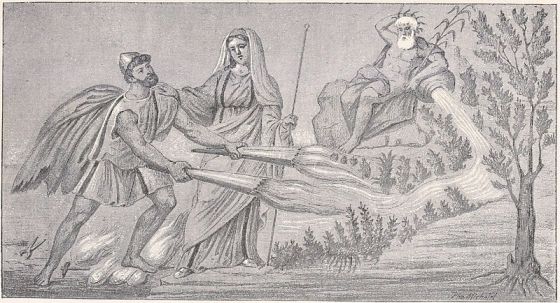
The waters of Scamander flowed through many tales, and so did his romantic entanglements. While not as prolific as some gods in the love department, his relationships were significant, intertwining his legacy with various figures in Greek mythology.
Idaea
Idaea, a mountain nymph, was one of Scamander’s most notable partners. Their union symbolized the harmonious relationship between rivers and the land. Idaea, representing the mountainous regions, was nourished by Scamander’s waters. Their love story is a testament to the interconnectedness of nature and the deities that personify its elements.
Glaucia
Another significant relationship was with Glaucia, a nymph. Their bond was deep, and together they brought forth several offspring who played various roles in Greek myths. Glaucia, with her serene and gentle nature, complemented Scamander’s sometimes tumultuous temperament, much like a calm pool within a raging river.
Scamander Offspring
The lineage of Scamander is vast, with his children playing pivotal roles in various myths, further intertwining the river god’s legacy with the land and waters of Troy.
Teucer
Teucer, born from Scamander’s union with Idaea, was a prominent figure in the Trojan War. As a warrior, he was renowned for his archery skills. His lineage, connecting him to both the land and waters of Troy, made him a formidable and respected figure on the battlefield.
Glaucus
Glaucus, the offspring of Scamander and Glaucia, was another significant figure. He too played a role in the Trojan War, standing as a defender of the city. His connection to both a river god and a nymph gave him unique attributes and powers, making him a notable figure in various myths.
Callirrhoe
Callirrhoe, another child of Scamander, was a water nymph. She inherited her father’s affinity for water and played a role in various myths, often assisting or interacting with heroes and other deities. Her tales often revolved around love and tragedy, echoing the sometimes tumultuous nature of rivers.
Depiction And Characteristics
Often visualized as an old man with a flowing beard, Scamander embodied the river’s ageless and ever-flowing nature. Symbols associated with him include the shield, representing his protective nature over the city of Troy.
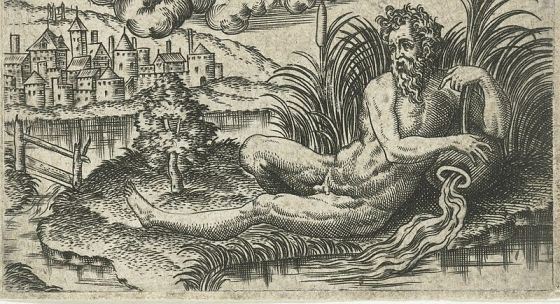
In myths, Scamander was portrayed as protective, especially towards Troy. His reactions, especially during the Trojan War, showcased his fierce loyalty to the land he nourished. The Ancient Greeks perceived him as a guardian deity, one who would rise in defense when his domain was threatened.
Powers and Symbol
As a river god, Scamander had control over the waters of his river. During the Trojan War, he even confronted Achilles, showcasing his might. His powers were not just limited to the physical realm; he also held sway over the spirits and nymphs of his river, commanding them in times of need.
The primary symbol associated with Scamander is the flowing river itself. This ever-moving body of water represents life, change, and the passage of time.
Scamander Roles And Responsibilities
Beyond personifying the river near Troy, Scamander had a protective role. He was the guardian of the city, and his waters were crucial for the sustenance and prosperity of its inhabitants. Additionally, as a deity, he played a part in various rituals and ceremonies, ensuring the city’s continued blessings and protection.
Astyanax and Scamandrius
A testament to Scamander’s significance in the Trojan narrative is the naming of Astyanax, the son of the Trojan hero Hector. Originally, the child was named Scamandrios in honor of the river god. This choice of name underscores the deep respect and reverence the Trojans had for Scamander, viewing him as a protector and nurturer of their land.
However, the people of Troy affectionately nicknamed the child Astyanax, which means “Lord of the City.” This name was not just a term of endearment but also a nod to the river or the river god, Scamander, emphasizing the deity’s role as the true guardian and lord of Troy. The dual naming of Hector’s son serves as a poignant reminder of the intertwined destinies of the city, its heroes, and the gods that watched over them.
Myths of Scamander
The River Scamander, also known by the gods as Xanthos, played a significant role during the Trojan War. His waters became the battleground for a fierce confrontation with the Greek hero Achilles.
The River’s Outcry
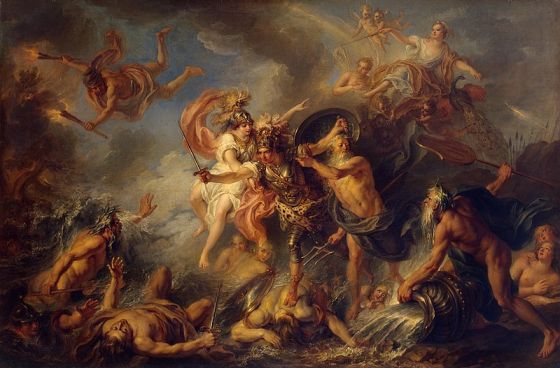
During the Trojan War, Achilles, in his fury, killed numerous Trojan warriors. He chased them down and, upon defeating them, threw their bodies into the Scamander River. The river became congested with the corpses of the fallen Trojans, obstructing its natural flow. Distraught and angered by the desecration of his waters, Scamander confronted Achilles. He spoke to the hero, expressing his anger and urging him to cease his onslaught and let the river flow freely. However, Achilles, driven by rage and grief over the death of his close friend Patroclus, paid no heed to the river god’s plea.
Divine Intervention
The conflict escalated when Scamander, in an attempt to stop Achilles, tried to drown him with his waters. The river surged and swelled, trying to engulf the hero. However, the gods intervened. Hera, fearing for Achilles, called upon Hephaestus, the god of fire. Hephaestus unleashed his flames, causing the waters of Scamander to boil and retreat. The fire god’s intervention saved Achilles from a watery demise.
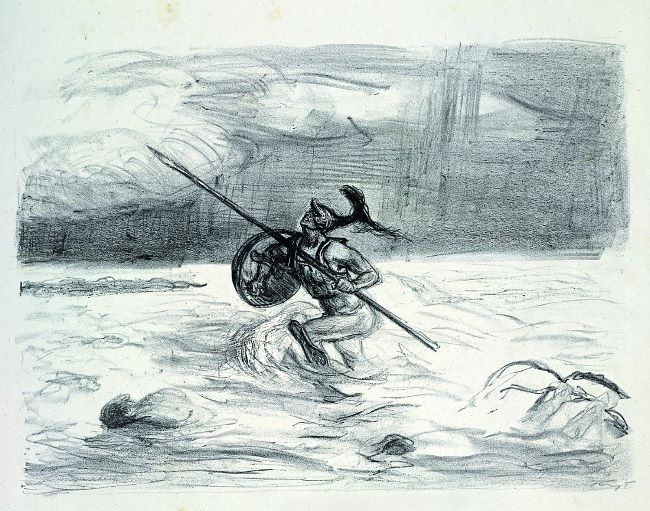
Hera’s intervention was not just out of concern for Achilles. The gods were divided in their allegiances during the Trojan War, with some favoring the Trojans and others the Greeks. Hera’s actions were also a part of the larger divine conflict playing out alongside the mortal one.
The River’s Retaliation
Despite Hephaestus’ intervention, Scamander did not relent. He called upon his brother river, Simoeis, to join him in his fight against Achilles (Homer, Iliad). Together, they sought to overwhelm the hero with their combined might. The rivers surged and roared, trying to sweep Achilles away. However, with divine aid on his side, Achilles managed to evade their wrath.
The confrontation between Achilles and Scamander is a testament to the intertwined fates of both mortals and gods in Greek mythology. Even the mightiest of heroes, like Achilles, could not escape the influence and intervention of the divine.
This episode from the Iliad highlights the profound respect and fear the ancient Greeks had for the natural world and its deities. Rivers, in particular, were seen as powerful entities, sources of both life and destruction. The Scamander’s clash with Achilles serves as a reminder of the river’s might and the consequences of incurring its wrath.
Representations Of Scamander In Art
Scamander, also known as Skamandros or Xanthos, has been a subject of interest in various art forms throughout history. While he might not be as frequently depicted as some of the more prominent gods or heroes, his significance in the Trojan War and his association with the river that surrounded Troy has made him a notable figure in the world of art.
“Water, or the Fight of Achilles against Scamander and Simoeis” by Auguste Couder, 1819
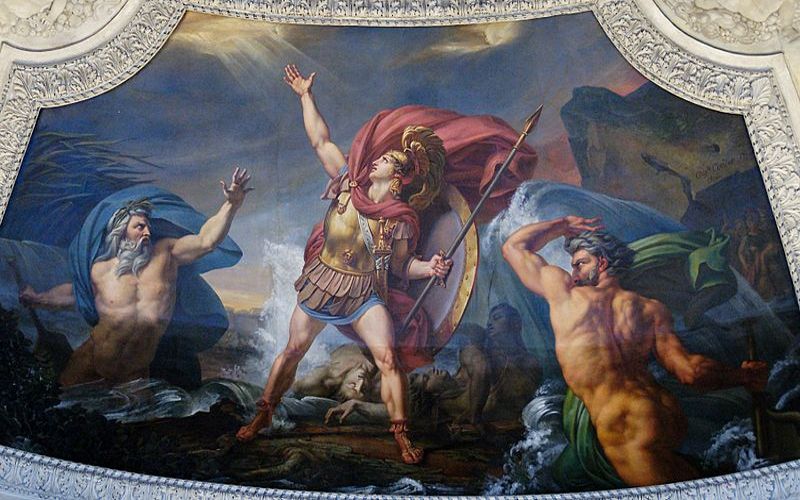
One of the most notable artworks that depict Scamander is “Water, or the Fight of Achilles against Scamander and Simoeis” by the French artist Auguste Couder. Created in 1819, this painting vividly captures the intense confrontation between Achilles and the river gods Scamander and Simoeis during the Trojan War. The artwork showcases the fury of the river and the determination of Achilles, providing a visual representation of the epic battle described in Homer’s Iliad.
Other Artistic Representations
Given both the river’s strategic importance in the war, and its role as a battleground, many artists have incorporated elements of the river and its god in their depictions of the war. These artworks often showcase the river’s might, its intertwining with the fates of the warriors, and its significance in the larger narrative of the Trojan War.
Mentions in Ancient Texts
Scamander, also known as Skamandros or Xanthos, has been mentioned in various ancient texts, shedding light on his significance in Greek mythology and his role in the Trojan War.
Homer’s Iliad
Homer’s Iliad is one of the most renowned ancient Greek epics, written around the 8th century BC. In this work, Scamander is depicted as a river god who sides with the Trojans during the Trojan War. He is notably called Xanthos by the gods and Scamander by men. This distinction might indicate that the name Xanthos refers to the god, while Scamander refers to the river itself. In the Iliad, Scamander confronts the Greek hero Achilles, leading to a significant conflict between the two. The river god tries to drown Achilles, but the intervention of gods like Hera, Athena, and Hephaestus saves the hero.
“Now swift Akhilleus (Achilles) would have killed even more Paionians (Paeonians) except that the deep-whirling River [Skamandros (Scamander)] spoke to him in anger and in mortal likeness.” – Iliad 21.211
Diodorus Siculus’ Library of History
Diodorus Siculus, a Greek historian from the 1st century BC, wrote the Library of History. In this work, he mentions that the first king of Troy, Teukros (Teucer), was the son of the River-god Scamander and a Nymph from Mount Ida.
“The first to rule as king over the land of Troy was Teukros (Teucer), the son of the River-god Skamandros (Scamander) and a Nymphe of Mt Ida.” – Library of History 4.75.1
Pseudo-Apollodorus’ Bibliotheca
The Bibliotheca is a compendium of Greek myths and heroic legends, traditionally attributed to Apollodorus of Athens. It mentions that Scamander was the son of the Titans Oceanus and Tethys. He was also the father to several notable figures, including King Teucer of Troy.
“Dardanos (Dardanus) left Samothrake (Samothrace) and came to the opposite mainland [the Troad]. That country was ruled by a king, Teukros (Teucer), son of the river Skamandros (Scamander) and of a Nymphe Idaia (Idaea).” – Bibliotheca 3.139
Philostratus the Elder’s Imagines
Philostratus the Elder, a Greek sophist of the 3rd century AD, wrote Imagines. In this work, he mentions that the river Xanthos (another name for Scamander) was considered to be born from Zeus.
“[The river] Meles through his son [Homer] will grant to… the [River] Xanthos (Xanthus) to be born from Zeus, and to Okeanos (Oceanus) that all rivers spring from him.” – Imagines 2.8
Frequently Asked Questions
Scamander defended Troy, especially when Achilles disrespected his waters by filling them with Trojan bodies.
He was the son of Oceanus and Tethys, making him a river god.
Yes, especially near Troy, where he was revered as a guardian deity.
Often as an old man with a flowing beard, surrounded by aquatic motifs.
Yes, Teucer, a warrior in the Trojan War, was one of his children.
While closely associated with Troy, his influence and reverence extended beyond the city due to his role in major myths.
Featured Image Credit: Marie-Lan Nguyen / Wikimedia Commons
